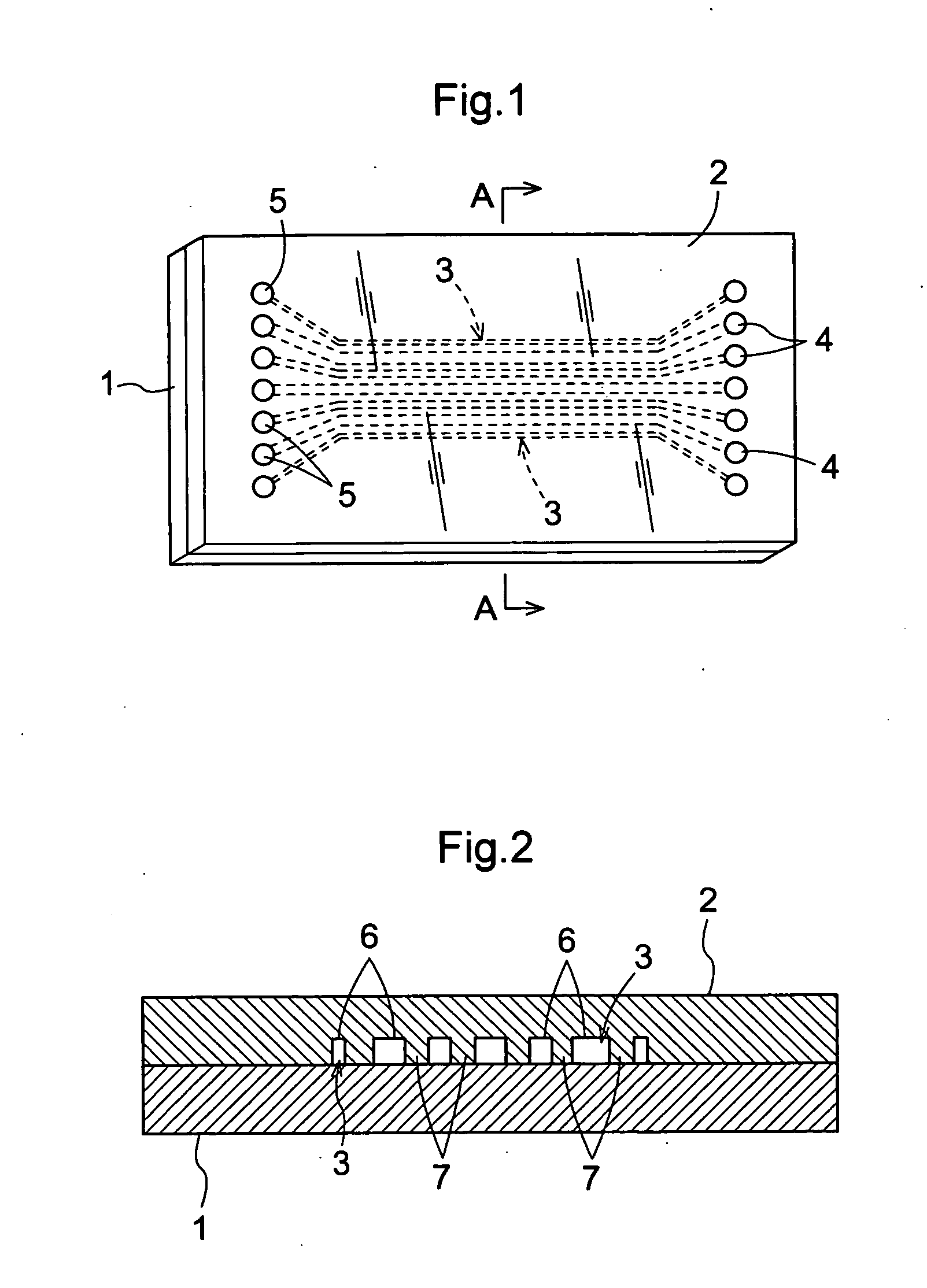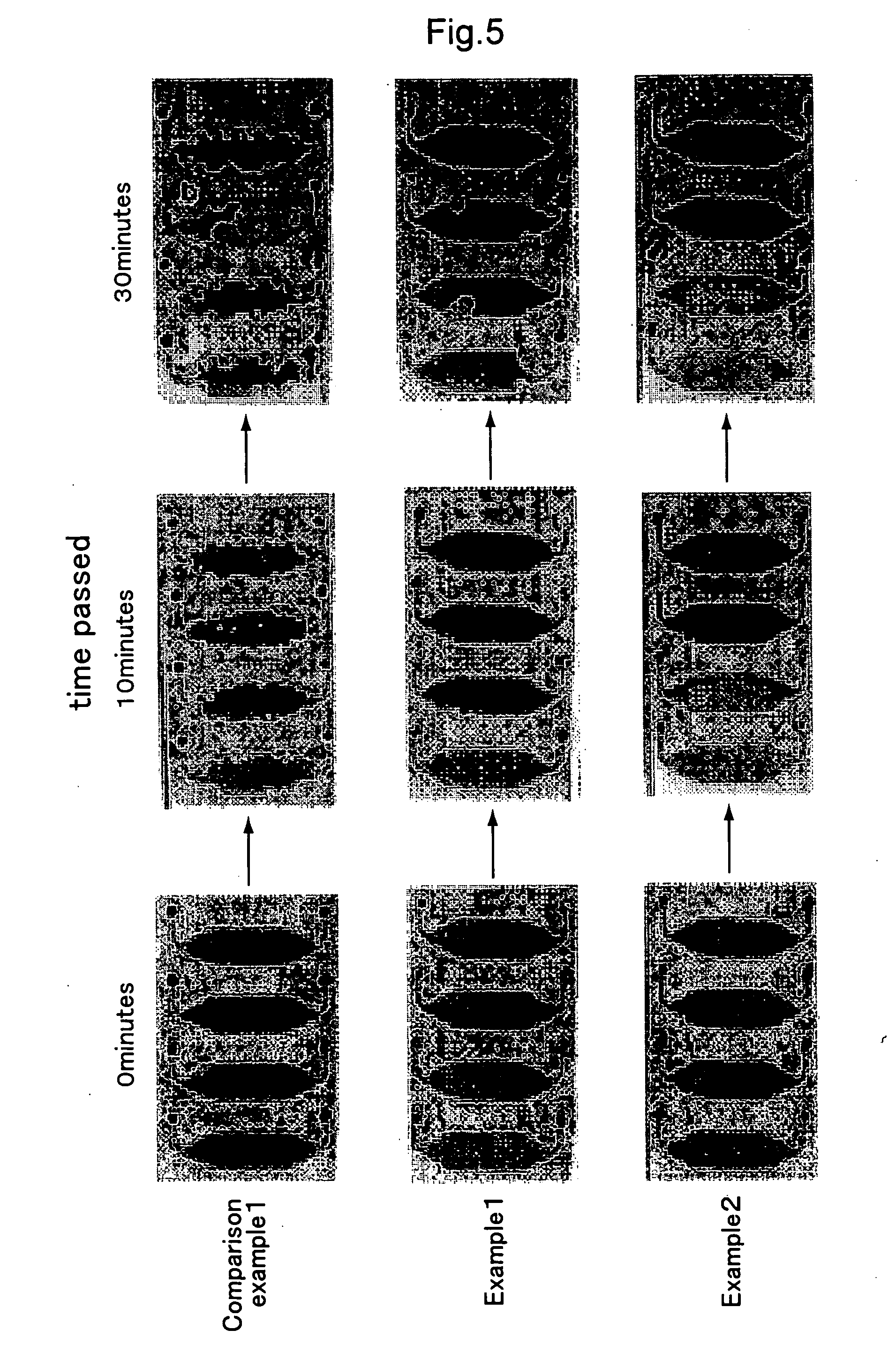Bio-chip
a technology of biochips and microorganisms, applied in the field of biochips, can solve the problems of inability to identify species under the microbial genus, difficulty in continuous or real-time on-site monitoring, and technological problems to be solved, so as to avoid dispersing samples and ensure the effect of testing process
- Summary
- Abstract
- Description
- Claims
- Application Information
AI Technical Summary
Benefits of technology
Problems solved by technology
Method used
Image
Examples
embodiment 1
[0128]FIG. 1 is a schematic view that shows the basic configuration of the present invention, and is a top view of the barcode array of the present invention. FIG. 2 is a cross-section taken along line A-A in FIG. 1, and schematically shows the barcode array of the present invention when it has been configured as Embodiment 1-1. Below, the top side in FIG. 2 is referred to as the “top”, and the bottom side is referred to as the “bottom”.
[0129] As shown in FIGS. 1 and 2, the barcode array of the present invention is configured from a first member 1 and a second member 2 fixedly disposed on the top face of the first member 1, and spaces that become reaction regions 3 disposed in a barcode shape are provided between the first member 1 and the second member 2.
[0130] The first member 1 is configured as a flat plate-shaped body. Surface treatment is performed on flat plate-shaped substrate of the second member 2, and a plurality of grooves 6 that extend in one direction are formed in pa...
embodiment 1-2
[0155] Next, the barcode array of embodiment 1-2 of the present invention is described with reference to FIG. 3. FIG. 3 is a is a cross-section taken along line A-A in FIG. 1, and shows the barcode array of the present invention when it has been configured as Embodiment 1-2. Parts of the configuration that are the same as the barcode array of Embodiment 1-1 have the same reference numerals in FIG. 3, and their explanation is omitted here.
[0156] With respect to both the first member 1 and the second member 2, surface treatment is performed on flat plate-shaped substrate, and a plurality of grooves 6 that extend in one direction are formed in parallel in a barcode shape on the surface that contacts the other member. That is, both the first member 1 and the second member 2 have a space structure in which a plurality of line-shaped grooves 6 alternate with dividing walls 7 that partition the grooves 6. The first member 1 and the second member 2 are configured so that when they have bee...
embodiment 1-3
[0158] Next is a description of the barcode array of Embodiment 1-3 of the present invention with reference to FIG. 4. FIG. 4 is a is a cross-section taken along line A-A in FIG. 1, and schematically shows the barcode array of the present invention when it has been configured as Embodiment 1-3. Parts of the configuration that are the same as the barcode array of Embodiment 1 have the same reference numerals in FIG. 4, and their explanation is omitted here.
[0159] With respect to both the first member 1, surface treatment is performed on flat plate-shaped substrate, and a plurality of linear convex portions 8 that extend in one direction are formed in parallel in a barcode shape on the surface that contacts the second member 2. With respect to the second member 2 as well, surface treatment is performed on flat plate-shaped substrate, and a plurality of linear groove portions 10 that can be fitted one-to-one with the linear convex portions 8 are formed in parallel on the surface that ...
PUM
| Property | Measurement | Unit |
|---|---|---|
| current temperature | aaaaa | aaaaa |
| size | aaaaa | aaaaa |
| width | aaaaa | aaaaa |
Abstract
Description
Claims
Application Information
 Login to View More
Login to View More - R&D
- Intellectual Property
- Life Sciences
- Materials
- Tech Scout
- Unparalleled Data Quality
- Higher Quality Content
- 60% Fewer Hallucinations
Browse by: Latest US Patents, China's latest patents, Technical Efficacy Thesaurus, Application Domain, Technology Topic, Popular Technical Reports.
© 2025 PatSnap. All rights reserved.Legal|Privacy policy|Modern Slavery Act Transparency Statement|Sitemap|About US| Contact US: help@patsnap.com



